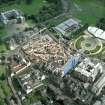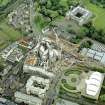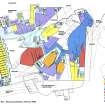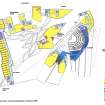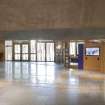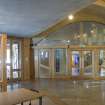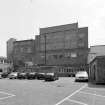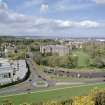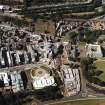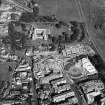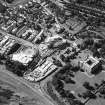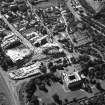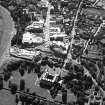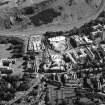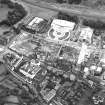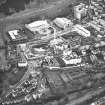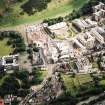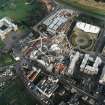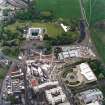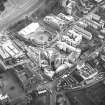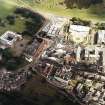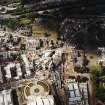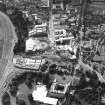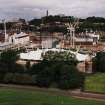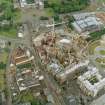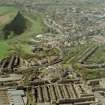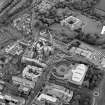Edinburgh, Canongate, Scottish Parliament
Parliament House (21st Century)
Site Name Edinburgh, Canongate, Scottish Parliament
Classification Parliament House (21st Century)
Alternative Name(s) Abbey Brewery; Lothian Hut; Holyrood
Canmore ID 159496
Site Number NT27SE 4322
NGR NT 26702 73840
NGR Description NT centred 26702 73840
Datum OSGB36 - NGR
Permalink http://canmore.org.uk/site/159496
First 100 images shown. See the Collections panel (below) for a link to all digital images.
- Council Edinburgh, City Of
- Parish Edinburgh (Edinburgh, City Of)
- Former Region Lothian
- Former District City Of Edinburgh
- Former County Midlothian
In 1998 Holyrood was chosen as the location for the new Scottish Parliament building after consideration of a number of sites in Edinburgh. The parliament complex, comprising offices, administration centre, debating chamber and committee rooms, was designed by the Catalan architect Enric Miralles and incorporates the 17th century Queensberry House within the building complex.
Information from RCAHMS (SC) 1 August 2007
Glendinning, M 2004
NT27SE 4322 centred 2670 7383
Formerly the site of Medieval Gardens and Abbey Brewery (see NT27SE 588) and incorporating Queensberry House (see NT27SE 32.00)
Design (1997 - 1998)
Project (1997)
The Public Monuments and Sculpture Association (http://www.pmsa.org.uk/) set up a National Recording Project in 1997 with the aim of making a survey of public monuments and sculpture in Britain ranging from medieval monuments to the most contemporary works. Information from the Edinburgh project was added to the RCAHMS database in October 2010 and again in 2012.
The PMSA (Public Monuments and Sculpture Association) Edinburgh Sculpture Project has been supported by Eastern Photocolour, Edinburgh College of Art, the Edinburgh World Heritage Trust, Historic Scotland, the Hope Scott Trust, The Old Edinburgh Club, the Pilgrim Trust, the RCAHMS, and the Scottish Archive Network.
Photographic Survey (2 July 1998)
Watching Brief (4 June 1998 - 12 June 1998)
Kirkdale Archaeology carried out archaeological monitoring of the site of the new parliament for Scotland during borehole survey. The fieldwork took place over 4th-5th June, and 12th June 1998.
Kirkdale Archaeology, 1998
Photographic Survey (24 March 1998 - 29 March 1998)
Prior to work being carried out on the new Holyrood Parliament site, Kirkdale Archaeology undertook a photographic survey of the site and surrounding area.
G Ewart 1998
Sponsor: Historic Scotland
Kirkdale Archaeology
Excavation (1998 - 2001)
Photographic Survey (3 August 1999)
Photographic Survey (8 November 1999)
Photographic Survey (12 August 2003)
Watching Brief (1 May 2009 - 1 March 2010)
NT 2671 7388 A total of 11 test pits were monitored, 1 May 2009–1 March 2010, prior to and during the erection of security barriers and bollards around the Scottish Parliament. The test pits reached a depth of c1m and encountered modern made ground and services. A post-medieval loam/garden soil was recorded at Reid’s Close.
Archive: RCAHMS
Funder: Scottish Parliament
Ross Murray – Headland Archaeology Ltd
Information also reported in Oasis (headland1-78659) 16 April 2013
Field Visit (26 January 2010)
The elegant sterling silver sculpture brings together the three honours of Scotland, the crown, sword and sceptre, into a simplified flowing whole. The central square-sectioned sceptre is topped by a smooth rock crystal, echoing the rock crystal in the real sceptre, with an oak-leaf engraved sphere below it (this relates to the orb in the crown). From near the bottom of the vertical axis, two moebius strips curve out, representing the crown, and derived from its arches, the broken-off point of the sword intersects the front moebius loop, pointing upwards at the angle of a St Andrew's Cross, thus creating a version of the Saltire.
The moebius strip represents for the artist 'an unending, continuous journey, one of returning and renewal.' (1) According to Graham Stewart, the oak leaves on the orb refer to the oldest part of the Scottish crown: the oak leaves taken by the goldsmith John Mosman from the previous crown to add to the present crown, made in 1540 for James V. Inside the oak leaves on the orb are wavy lines, which echo those cast in concrete on the ceilings in the Scottish Parliament Building, and suggest contour maps: a reference to the land, and a tribute to the architect of the Scottish Parliament Building, Enric Miralles.
Graham Stewart liked the idea of the old and new combined.
In 2004 Graham Stewart and a number of other Scottish silversmiths, were invited by the Incorporation of Goldsmiths of the City of Edinburgh, to submit a design for a silver sculpture for the new Scottish Parliament Building, to be presented by Her Majesty The Queen at the opening ceremony. The sculpture was to be abstract, and to incorporate the symbolism of the Honours of Scotland. Stewart's design was selected.
The Honours of Scotland are the crown, sword and sceptre, and are Scotland's crown jewels. They are the oldest royal regalia in the U.K. and are kept in the Crown Room at Edinburgh Castle.
Inscriptions : On silver plaque on top of pedestal (incised letters): Sculpture by / GRAHAM STEWART / [5 hallmarks]
On silver plaque on front of pedestal (incised letters): Commissioned by / THE INCORPORATION OF / GOLDSMITHS / OF THE CITY OF / EDINBURGH / and Presented by / HER MAJESTY THE QUEEN / on the day of the / OPENING OF HOLYROOD / SATURDAY 9 OCTOBER / 2004 / [5 hallmarks]
Signatures : Silversmith's maker's mark (GLS within a shield) is the highest of the five hallmark symbols arranged vertically on the lowest part of the sceptre.
Design period : 2004
Year of unveiling : 2004
Unveiling details : Presented to The Scottish Parliament by H.M. The Queen on 9 October 2004, to mark the opening of The Scottish Parliament Building
Information from Public Monuments and Sculpture Association (PMSA Work Ref : EDIN1061)
Field Visit (26 January 2010)
A collection of 100 sentences, each in individual handwriting, is re-created in white glazed porcelain and presented on three floor-to-ceiling wall boards.
Originally, the brief was to recognise in an imaginary way the contribution of women who had campaigned for equal suffrage, and helped to further democracy. This was broadened to include all women who had made a significant contribution to life, culture or democracy in Scotland. The artist undertook a journey across Scotland to meet 100 women, each woman being asked to refer her to another woman. Each wrote a sentence about a woman she felt had made an important contribution.
Inscriptions : [The whole work could be regarded as an inscription (100 sentences)].
Signatures : None (but the artist wrote one of the sentences).
Design period : 2005-2006
Year of unveiling : 2006
Unveiling details : 14 December 2006
Information from Public Monuments and Sculpture Association (PMSA Work Ref : EDIN1553)
Watching Brief (3 October 2017)
A watching brief was undertaken, 3 October 2017, during landscaping work within the Scottish Parliament Campus. The only finds encountered in the topsoil were fragments of shell and Scottish reduced ware, which suggested the area had probably been used as a garden space.
Archive: NRHE (intended)
Funder: Lee Boyd Designers and Architects
Genevieve Shaw – AOC Archaeology Group
(Source: DES, Volume 18)










































































































